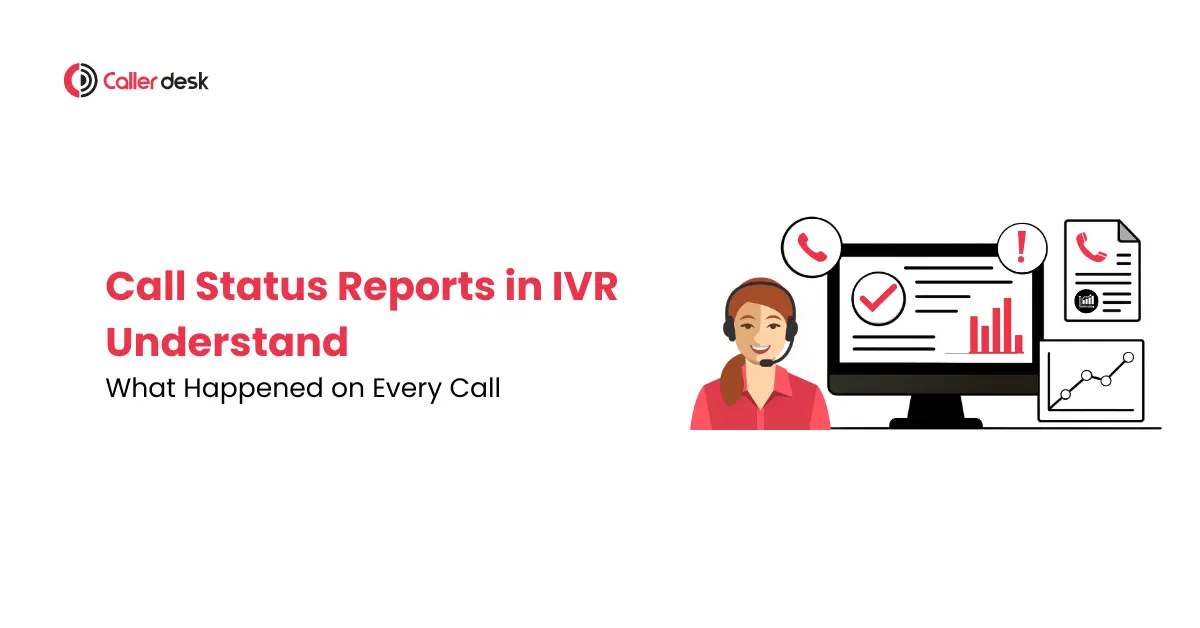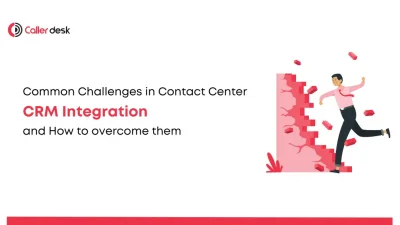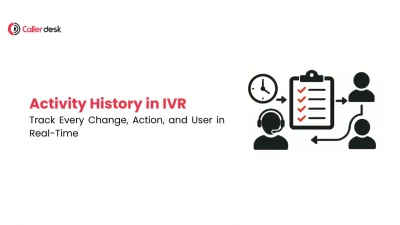When you run a business that relies on phone communication, knowing what happened on each call is critical.
Did the call go through? Was it missed by the agent? Did the customer hang up? Or did the system fail due to network issues?
With Call Status Reports in IVR, you get a detailed explanation of every call outcome — so you can understand what went right, what went wrong, and what to fix.
Whether you’re running a support center, sales desk, delivery service, or appointment-based business, understanding these reports helps you:
- Monitor call performance
- Improve agent accountability
- Fix technical issues faster
- Reduce missed opportunities
What Are Call Status Reports?
Call Status Reports give you a clear summary of every call your business handles — both incoming and outgoing. These reports show how each call ended, using simple status codes.
There are two types of statuses:
- Incoming Call Statuses – For calls received by your business
- Outgoing Call Statuses – For calls made by your team
Each status helps you understand whether the call was:
- Answered successfully
- Missed or ignored
- Failed due to a technical issue
- Redirected to another number
- Disconnected before connecting
With this information, you can:
- Track your team’s calling performance
- Spot problems quickly (like too many missed calls)
- Improve customer response rates
- Make better decisions using real data
In short, Call Status Reports help you stay on top of your call activity — so nothing gets missed or overlooked.
Real Example: When Confusion Turned Into Clarity
Sonal runs a call center for a financial services company. Her manager noticed a rising number of NOANSWER and UNAVAILABLE calls in the reports and assumed agents were missing customer calls.
Sonal wasn’t sure — the report had multiple technical terms she didn’t fully understand.
After learning what each status meant, Sonal realized:
- Some calls were missed due to agent unavailability
- Some were failing because of network congestion
- Others were being abandoned by the caller before the agent could answer
By using these insights, she:
- Re-trained her team on prompt pickups
- Reported technical issues to the provider
- Adjusted call routing logic in the IVR
The result? More answered calls, fewer support delays, and a clearer communication flow between her team and management.
Incoming Call Statuses (When Customers Call You)
Each of the following statuses explains the result of the call attempt from a customer’s side:
| Status | What It Means |
| ANSWER (16) | Call was successfully answered by the agent. |
| CANCEL (0) | Caller hung up before the call could be answered. |
| NOANSWER (0 – Agent) | Agent didn’t pick up the ringing call. |
| BUSY (17) | The number was busy when the call came in. |
| CONGESTION | Network issue – call couldn’t be routed due to overload. |
| UNAVAILABLE (19) | The number was unreachable (turned off, poor signal). |
| CHANUNAVAIL | No SIP channel available to take the call. |
| Not connected | Caller reached IVR but the call wasn’t forwarded further. |
| AgentEngaged | The assigned agent was already on a call. |
| AgentonRing | Agent’s phone was already ringing for another call. |
| AbandonedCall | Caller disconnected after hearing retry/hold music. |
| Transfer to agent | The call is currently being routed to an agent. |
| Picked | Agent picked up the call successfully. |
Outgoing Call Statuses (When Your Team Calls a Customer)
These statuses show what happened when your agent or system attempted to place a call:
| Status | What It Means |
| ANSWER (16) | Call was answered and completed successfully. |
| NOANSWER (0) | The call rang but wasn’t picked up by the recipient. |
| BUSY (17) | The recipient’s line was busy. |
| CONGESTION | The call couldn’t connect due to network issues. |
| UNAVAILABLE (19) | The recipient’s number couldn’t be reached. |
| CHANUNAVAIL | No SIP channel was available to complete the call. |
| Not connected | Call was initiated but not forwarded to the recipient. |
| Transfer to agent | The system is transferring the call to a specific agent. |
| Picked | Call was picked up by the customer. |
Why Call Status Reports Are a Must-Have Feature
Knowing how many calls your team handled is useful — but it’s not enough. To truly understand your call performance, you need to know what happened during each call, and why it ended the way it did.
That’s where Call Status Reports help. They don’t just count calls — they tell you the full story behind each one. Here’s how this feature supports smarter business decisions:
1. Understand Why Calls Fail or Get Missed
Every failed call has a reason. Call Status Reports show whether the issue was:
- An agent not answering (NOANSWER)
- A customer hanging up too early (CANCEL or AbandonedCall)
- A network problem (CONGESTION or UNAVAILABLE)
With this data, you can stop guessing and start fixing the real problem.
2. Improve Agent Training with Real-World Data
These reports let you see how quickly agents answer calls, how many calls go unanswered, and what happens afterward.
You can use this information to:
- Guide agent coaching sessions
- Set response time goals
- Improve team accountability
3. Spot and Fix Technical Issues Faster
Some call failures have nothing to do with your team — they’re caused by technical issues.
Statuses like CONGESTION or CHANUNAVAIL alert you to:
- Network congestion
- SIP channel errors
- Connectivity issues
This helps your IT or telecom team resolve problems before they affect more calls.
4. Reduce Missed Calls and Improve Customer Experience
Call Status Reports highlight when customers are giving up — like hanging up after long wait times or hitting a dead end in the IVR.
By identifying these patterns, you can:
- Adjust staffing during peak hours
- Simplify IVR paths
- Enable voicemail or callback features
These changes help reduce missed opportunities and create a better caller experience.
5. Build Transparent Reports for Teams and Clients
If you share performance reports with internal teams or clients, accurate call status data makes a big difference.
You can easily build:
- Weekly summaries of call outcomes
- Agent-level performance dashboards
- Client-facing reports with full transparency
This boosts trust, helps with decision-making, and supports long-term growth.
Real Business Use Case: Delivery Team Improves Pickup Rate
A delivery company noticed a spike in “NOANSWER” statuses in outgoing call reports. After digging deeper, they realized these calls were being made during staff break hours — when agents weren’t available to respond.
They implemented two simple changes:
- Scheduled automated follow-up calls during active hours
- Enabled voicemail fallback for missed calls
In just one week, they saw:
- 35% increase in call pickup rates
- Fewer delivery reschedules
- More satisfied customers
Conclusion
Your IVR system sees every call. But to truly understand what’s happening, you need to know what those statuses mean.
When you start reading your reports the right way:
- Patterns emerge
- Gaps in performance become clear
- Decisions become data-driven
With CallerDesk’s Call Status Reports, you don’t just see call logs — you gain powerful insights to optimize your team, improve customer experience, and stay ahead of communication issues.
Behind every status is a reason. Now you have the tools to find it.
Frequently Asked Question
1. What are Call Status Reports in IVR?
Call Status Reports give a detailed summary of every call made or received through your IVR system. They show whether the call was answered, missed, failed due to technical issues, or disconnected — along with clear status labels like ANSWER, NOANSWER, BUSY, or CONGESTION.
2. How do Call Status Reports help improve team performance?
These reports help managers see how agents handle calls — such as how fast they answer, how many calls are missed, or if calls fail due to issues like network problems. This real-time data helps improve agent training, track accountability, and boost customer response times.
3. What do different call statuses mean in the report?
Some common status codes include:
ANSWER – The call was picked up.
NOANSWER – The agent or customer didn’t answer.
CANCEL – Caller hung up before connection.
CONGESTION – Network issue prevented the call.
UNAVAILABLE – The phone was unreachable.
Each status helps explain what happened and why the call ended.
4. Can Call Status Reports help fix technical problems faster?
Yes. If you see repeated statuses like CONGESTION or CHANUNAVAIL, it may point to SIP or network issues. This allows your IT or telecom team to take quick action and prevent further call failures.
5. Why should businesses regularly check Call Status Reports?
Regularly reviewing these reports helps you reduce missed calls, improve agent response, and find areas where the IVR or call handling process can be improved. It also helps in creating transparent reports for teams or clients and making data-driven decisions for better performance.





